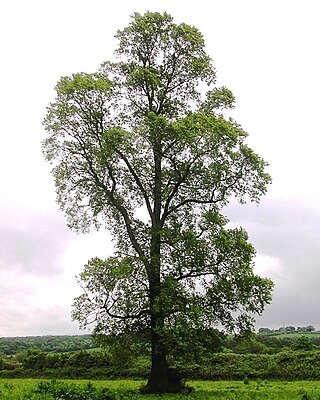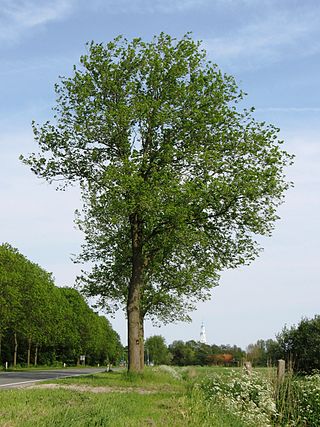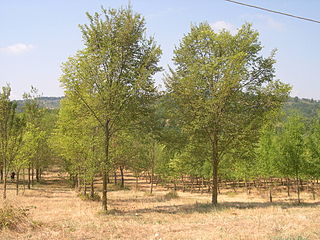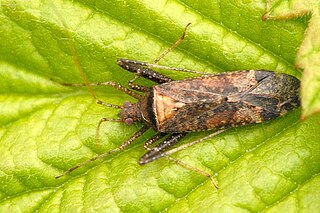
Elms are deciduous and semi-deciduous trees comprising the genus Ulmus in the family Ulmaceae. They are distributed over most of the Northern Hemisphere, inhabiting the temperate and tropical-montane regions of North America and Eurasia, presently ranging southward in the Middle East to Lebanon and Israel, and across the Equator in the Far East into Indonesia.

Ulmus × hollandica 'Commelin' is a Dutch hybrid cultivar released for sale in 1960. The tree was raised at Baarn as clone 274 by the Foundation Willie Commelin Scholten Phytopathological Laboratory in 1940, from a crossing of Ulmus × hollandica 'Vegeta' and clone 1, an Ulmus minor selected from a 1929 elm seedlings lot obtained from the Barbier nursery, Orléans.
Ulmi may refer to several places in Romania:

Ulmus 'Arno' is an Italian hybrid cultivar derived from a crossing of 'Plantyn' with the Siberian Elm Ulmus pumila clone S.2. It was raised by the Istituto per la Protezione delle Piante (IPP) in Florence, and released in 2007. However, 'Arno' was not a commercial success; propagation had ceased by 2010, and it is no longer patent protected.

Ophiostoma ulmi is a species of fungus in the family Ophiostomataceae. It is one of the causative agents of Dutch elm disease. It was first described under the name Graphium ulmi, and later transferred to the genus Ophiostoma.
Ulmus wallichiana subsp. wallichiana was identified by Melville and Heybroek after the latter's expedition to the Himalaya in 1960.
Ulmus wallichiana var. tomentosa was identified by Melville & Heybroek after the latter's expedition to the Himalaya in 1960.

Belcești is a commune in Iași County, Western Moldavia, Romania, situated on the Bahlui River 44 km from Iași. One of the county's largest communes, with a population of 10,555 in 2011, it is composed of six villages: Belcești, Liteni, Munteni, Satu Nou, Tansa, and Ulmi.

Panonychus ulmi, the European red mite, is a species of mite which is a major agricultural pest of fruit trees. It has a high reproductive rate, a short generation time and produces many broods in a year, all of which contribute to its pest status. It has a cosmopolitan distribution, and a very wide host range, having been found on the following plants:

Ulmi is a commune located in Giurgiu County, Muntenia, Romania. It is composed of eight villages: Căscioarele, Drăgăneasca, Ghionea, Icoana, Moșteni, Poenari, Trestieni and Ulmi.

Ulmi is a commune in Dâmbovița County, Muntenia, Romania. It is composed of eight villages: Colanu, Dimoiu, Dumbrava, Matraca, Nisipurile, Udrești, Ulmi and Viișoara.
Digamasellidae is a family of mites in the order Mesostigmata.
Dendrolaelaps is a genus of mites in the family Digamasellidae. There are more than 170 described species in Dendrolaelaps.

Ameroseius is a genus of mites in the family Ameroseiidae. There are more than 60 described species in Ameroseius.
Dendrolaelaps foveolatus is a species of mite in the family Digamasellidae.
Dendrolaelaps uncinatus is a species of mite in the family Digamasellidae.
Multidendrolaelaps is a genus of mites in the family Digamasellidae. There are at least 30 described species in Multidendrolaelaps.
In the 10th edition of Systema Naturae, Carl Linnaeus classified the arthropods, including insects, arachnids and crustaceans, among his class "Insecta". True bugs and thrips were brought together under the name Hemiptera.

Phytocoris ulmi is a species of plant bugs belonging to the family Miridae, subfamily Mirinae.









